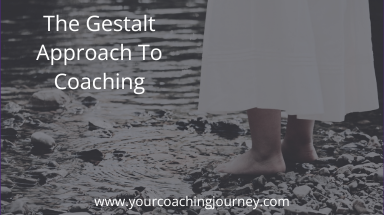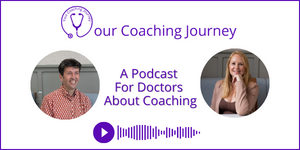Prefer to listen?
This blog post forms the basis of our podcast on The Gestalt Approach To Coaching, which you can listen to here.
Gestalt coaching comes from Gestalt therapy which was the creation of Laura and Fritz Pearls. They were a German couple who moved to America after the Second World war and set up the Gestalt Institute in New York. Laura was a psychotherapist and was involved in Gestalt psychology before it became a form of psychotherapy. Fritz was a psychiatrist and a psychotherapist. They separated in the 60s and Laura stayed in New York, and Fritz went to California and set up another institute there.
What Does ‘Gestalt’ Mean?
Gestalt is a German word that doesn’t have a literal translation in English, but it generally means the whole or a whole or complete experience.
For example: Our experience of running a coaching diploma programme is a gestalt, and within that there are a number of workshops. Each of these is a smaller gestalt within the first. And when each one is finished, that gestalt is finished. And when all the workshops are finished, the diploma comes to an end, that experience will be over.
What does the whole experience of a gestalt have to do with coaching?
We should be able to flow smoothly through a whole experience from the beginning to the end: We bring something into our awareness and explored it, and then engaged with it and maybe worked towards a desired outcome, that will finish and it will all be over, and then our attention will die away and turn to something else and that will be a new gestalt that we start to explore.
That should be how it works. But sometimes things don’t work that way and people become a little bit stuck in their gestalt at some point. This is where coaching can really help them to become unstuck and to move again more smoothly through their gestalt.
Within the coaching room, we can start to look at where someone is stuck and maybe look at that cycle of experience and identify at what point they are stuck and how the coaching can help them to move on.
If we think about coaching, it fits really nicely with Gestalt, because there’s always a future focus, a desired outcome. And we would like people to get to their desired outcome and then move on to something else. It might be an extension of what they’ve just explored, but we want that to come to an end and then for them to move further on.
Coaching can also help if someone is at the end of an experience, and not letting go of it, they’re still attached to it in some way.
What Is The Gestalt Approach To Coaching?
As a Gestalt coach, we’re exploring, uncovering, understanding what’s really going on for the coachee from the inside out and helping them direct their energy into fully experiencing and accepting what’s going on in the present. It’s very much about working in the present and becoming who you are. This will then allow the flow of change.
It’s about self awareness and self responsibility: increasing the awareness of the coachee so that they understand themselves better and their connection to the world. And then once they start to become more who they are, they can take responsibility for their choices and the consequences of those choices, and do it in a really authentic way.
That doesn’t mean that if they have limiting beliefs, which is something we explored in the cognitive behavioural approach to coaching, or unhelpful thinking or behaviours, that we just leave them where they are and say that’s just them, they’re just being who they are. There is still that opportunity for change.
That’s because some of the beliefs, biases, defence strategies that we all engage in, the barriers that we put up around us can be what lead us to becoming stuck. In Gestalt, these are referred to a Creative Adjustments, and we make them as we go through life, in order to protect ourselves in some way. We can work through these in the coaching room.
What Is a Creative Adjustment?
If we think about it from a physical perspective and a physical injury. If you have a knee injury, you might hobble or limp for a while. That’s a creative adjustment that you make to protect your knee and stop you feeling pain. For some people, they will have emotional pain or experiences that are uncomfortable. As a result they might make creative adjustments to stop that ‘pain’ and head off the discomfort, and those become potential fixed gestalts that we can’t move past.
In the coaching room, therefore, we might need to do some work to get back to the real person that isn’t making those creative adjustments.
What Are The Key Elements of Gestalt Coaching?
Awareness
We need to be very aware of what’s going on in the coaching room with the coachee. We are listening and looking for:
- the words they’re saying,
- their tone of voice.
- any emotion that comes up in their voice.
- their facial expression whilst they’re talking.
- any changes in their body language.
It’s all about our awareness of the coachee, and by playing back to them what we are noticing, increasing their awareness of what’s going on for them.
The Present Moment
It’s very much about working in the present. We can’t change the past, it’s gone. We can’t work in the future because it hasn’t arrived yet. We have to bring everything into the present so that we can work in the here and now in the coaching room with the coachee.
Experience
This is the way in which the coachee experiences and thinks about things. We’re trying to connect with what’s actually happening for the coachee: cognitively, emotionally, physiologically, and to a certain extent, spiritually. We really want to get to understand what’s going on for them. We’re also trying to get a real sense of understanding about what’s happening in the here and now as the coachee starts to address issues. Now those issues might seem to have a place in the past or place in the future, but they’re actually in the here and now because the coaches decided to bring them into the coaching room, they’re in their conscious awareness.
Relationship Centred
It’s very much about that connection that the coach has with the coachee. If we think about transactional analysis, we’ve got that ‘adult to adult’ connection, and in Gestalt, it’s referred to as the ‘I-thou connection’. We’re connecting with that other person on the same level.
It’s also the recognition that the coachee has a relationship with other people and their environment and everything in their world is interconnected and having an effect on them.
Change
The principle in gestalt is that change is constant:
So you will read this article and leave as a different person. Something will have changed as a result of you reading this.
The Greek philosopher, Heraclitus said, ‘no one can step into the same river twice’. That’s the point with Gestalt, we are constantly changing, even though we might not be noticing it. So rather than saying that you want to head for this specific goal, it’s recognising that things are going to change anyway.
Change can only happen in the present:
Change isn’t going to happen in the future, and it can’t happen in the past. So in Gestalt coaching, we focus on the present, bring everything the coachee’s discussing into the present moment.
Paradoxical Change:
This concept within Gestalt is that idea that the more we strive to change, to become what we’re not, the more we stay the same. But if we think of it from the opposite way, if we accept who we are as a whole person and really accept what lies at the heart of our being, then we start to change naturally, and that change will start to flow naturally. By going back to and focusing on who you are, you will find your way to make the change that you need.
When Is Gestalt Useful In The Coaching Room?
There are some obvious places where Gestalt coaching is a perfect fit and then other places where it’s perhaps not going to work at all. It isn’t really useful if someone wants coaching around working on tactical objectives, very operational, step by step action planning,
Neither is it useful for logical analysis or learning new skills.
Where it’s really useful is:
- around any ambiguity or ambivalence that someone has.
- working on relationships
- thinking about the client’s identity and becoming more who they truly are.
- when there’s any work to be done around a coachee’s future vision, creativity and innovation.
Practically How Do We Use It In The Coaching Room?
We will experiment, we’ll get the coachee to move around, we’ll get them out of their seat. We’ll get them to look at things from different perspectives, we might get them to sit in different chairs, to explore the world in different ways. We might ask them to exaggerate gestures that they’re making, to see what it feels like, to really overemphasize. If they start talking about something and start to make a gesture and go, what does that mean as you’re making that gesture? Just ask them to amplify that for you, make that bigger. How does it feel for it to be bigger?
The great thing about Gestalt is it’s an experiment. If it doesn’t work, we can move back from it and we can try a different experiment.
The Empty Chair Exercise
One of the most common things that people will use is the empty chair exercise. That is about getting someone to see things from other people’s perspective. We will ask the coachee to metaphorically sit in someone else’s chair and talk as though they’re having that conversation in the moment. For example, if you’ve got someone who had a conversation a week ago with their boss and they start talking about it, it’s then a narrative of ‘he said – I said’ and it all becomes just a bit of a story. Instead, we can bring that conversation into the room. And ask,
- let’s hear from you what was going on for you in that conversation, and they’ll talk through it.
- And then, now be that other person, what would they say?
- Let’s be your colleague. You’re now your colleague. What’s going on for you in that conversation?
And to get them to talk it through as though they are each person. It allows them to stand in their shoes, sit in their seat, it allows you to see things from a different perspective, and suddenly the story they were telling yourself perhaps isn’t quite the same story. Something has changed.
This exercise can be really helpful and it can be really, really powerful.
Gestalt Coaching is definitely an approach that you will want to explore if you’re interested in transformational change, and not just about achieving goals, but the person becoming different or becoming more who they truly are. And, naturally, it’s one of the approaches we cover on our Transformational Coaching Diploma.
If you’d like to find out more about ‘gestalt cycle of experience’ as a model we will be exploring this is a future article and podcast.



